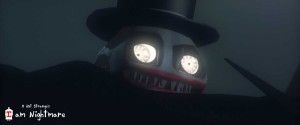
The film follows his two previous independent animated films, Heart Strings Marionette (2012) and We Are the Strange (2007), which premiered at the 2007 Sundance Film Festival and was honored with the Golden Prize for most groundbreaking film at the Fantasia Film Festival in Montreal the same year.
“Strange’s latest animated effort demonstrates what the tools in the hands of a visionary and proficient artist are capable of,” said Paul Babb, president/CEO MAXON US.
Using CINEMA 4D, Strange spent a little over a year making I am Nightmare, a 127-minute film that features 1,420 shots. Inspired by the works of filmmaker David Lynch and Japanese animator Osama Tezuka, the film focuses on a mother who moves her five foster children to a place called The Town That Never Changes. Shortly after arriving they discover a secret they weren’t supposed to uncover. Every night, the children are forced to patrol the woods to keep the monsters at bay while the adults do nothing to help them.
Strange, who refers to the San Jose, Calif.-based Mysterious Doll Studios as being the “world’s smallest CG feature animation studio,” coined the term “Uberector” to describe the role of an artist who makes 3D animated feature films alone and does more than direct during the filmmaking process. He underscored the critical role a 3D software package plays in streamlining the creative process that involves various elements from acting/voices, animation, editing and camera work.
“There are other, more complex packages available but I am an artist, not a technician, so I use tools like CINEMA 4D that allow me to accelerate the overall workflow and realize my cinematic dreams intuitively within budget,” said Strange.
MoGraph was used to build sets and was especially helpful for building structures that have repeating elements. The film’s stylized doll-like characters were created using a combination of keyframe and procedural animation techniques, while BodyPaint 3D was used to paint all the models and texture all the props and sets to create a rough, hand-painted look instead of simply adding a pre-made texture to the assets.
Among the biggest challenges Strange faced was managing the assets of the more than 1,400 shots in the film. Strange used the Content Browser in CINEMA 4D as a “living storyboard” to organize all the elements in his “digital backlot.”
“After animating a shot, I would save it to a folder displayed in the Content Browser so that I could refer to all the shots, easily re-use camera setups and animations and have an idea of the visual flow of the film to make editorial decisions,” explained Strange. He also relied on CINEMA 4D’s Character Animation and Motion Clip system to create common animations for all the characters in the film and convert walk and run cycles into motion clip loops that were then used to create a collection of pre-made animations that could later be dragged and dropped into different characters and new scenes, as needed.
“Using CINEMA 4D’s motion system I could dip into my library of saved walks and runs to really speed things up to more easily re-time the motion clips to better fit the shots.”
To achieve the stylized and foggy mood that obscured “the creepy things lurking in the dark,” Strange relied on the lighting system in CINEMA 4D including a mix of the Volumetric and Visible Lights functions. The Vibrate Tags and Displacement Deformers in the software also enabled the filmmaker to add weird random movements to the monster characters ranging from undulating tentacles or pulsating skin that could be dragged and dropped into scenes using the XPresso visual node-based expressions feature.





